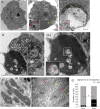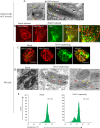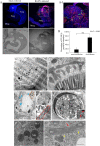Fibrillar structures induced by a plant reovirus target mitochondria to activate typical apoptotic response and promote viral infection in insect vectors
- PMID: 30653614
- PMCID: PMC6353215
- DOI: 10.1371/journal.ppat.1007510
Fibrillar structures induced by a plant reovirus target mitochondria to activate typical apoptotic response and promote viral infection in insect vectors
Abstract
Numerous plant viruses that cause significant agricultural problems are persistently transmitted by insect vectors. We wanted to see if apoptosis was involved in viral infection process in the vector. We found that a plant reovirus (rice gall dwarf virus, RGDV) induced typical apoptotic response during viral replication in the leafhopper vector and cultured vector cells, as demonstrated by mitochondrial degeneration and membrane potential decrease. Fibrillar structures formed by nonstructural protein Pns11 of RGDV targeted the outer membrane of mitochondria, likely by interaction with an apoptosis-related mitochondrial protein in virus-infected leafhopper cells or nonvector insect cells. Such association of virus-induced fibrillar structures with mitochondria clearly led to mitochondrial degeneration and membrane potential decrease, suggesting that RGDV Pns11 was the inducer of apoptotic response in insect vectors. A caspase inhibitor treatment and knockdown of caspase gene expression using RNA interference each reduced apoptosis and viral accumulation, while the knockdown of gene expression for the inhibitor of apoptosis protein improved apoptosis and viral accumulation. Thus, RGDV exploited caspase-dependent apoptotic response to promote viral infection in insect vectors. For the first time, we directly confirmed that a nonstructural protein encoded by a persistent plant virus can induce the typical apoptotic response to benefit viral transmission by insect vectors.
Conflict of interest statement
The authors have declared that no competing interests exist.
Figures








Similar articles
-
Filamentous Structures Induced by a Phytoreovirus Mediate Viral Release from Salivary Glands in Its Insect Vector.J Virol. 2017 May 26;91(12):e00265-17. doi: 10.1128/JVI.00265-17. Print 2017 Jun 15. J Virol. 2017. PMID: 28381575 Free PMC article.
-
Autophagy pathway induced by a plant virus facilitates viral spread and transmission by its insect vector.PLoS Pathog. 2017 Nov 10;13(11):e1006727. doi: 10.1371/journal.ppat.1006727. eCollection 2017 Nov. PLoS Pathog. 2017. PMID: 29125860 Free PMC article.
-
Assembly of viroplasms by viral nonstructural protein Pns9 is essential for persistent infection of rice gall dwarf virus in its insect vector.Virus Res. 2015 Jan 22;196:162-9. doi: 10.1016/j.virusres.2014.11.025. Epub 2014 Nov 29. Virus Res. 2015. PMID: 25455335
-
Rice Reoviruses in Insect Vectors.Annu Rev Phytopathol. 2016 Aug 4;54:99-120. doi: 10.1146/annurev-phyto-080615-095900. Epub 2016 May 25. Annu Rev Phytopathol. 2016. PMID: 27296147 Review.
-
Complex interactions between insect-borne rice viruses and their vectors.Curr Opin Virol. 2018 Dec;33:18-23. doi: 10.1016/j.coviro.2018.07.005. Epub 2018 Jul 19. Curr Opin Virol. 2018. PMID: 30031984 Review.
Cited by
-
The nucleocapsid protein of rice stripe virus in cell nuclei of vector insect regulates viral replication.Protein Cell. 2022 May;13(5):360-378. doi: 10.1007/s13238-021-00822-1. Epub 2021 Mar 6. Protein Cell. 2022. PMID: 33675514 Free PMC article.
-
Alteration of mitochondrial function in arthropods during arboviruses infection: a review of the literature.Front Physiol. 2025 Feb 13;16:1507059. doi: 10.3389/fphys.2025.1507059. eCollection 2025. Front Physiol. 2025. PMID: 40017802 Free PMC article. Review.
-
Apoptotic neurodegeneration in whitefly promotes the spread of TYLCV.Elife. 2020 Jul 30;9:e56168. doi: 10.7554/eLife.56168. Elife. 2020. PMID: 32729829 Free PMC article.
-
RNAi-Based Functional Genomics in Hemiptera.Insects. 2020 Aug 20;11(9):557. doi: 10.3390/insects11090557. Insects. 2020. PMID: 32825516 Free PMC article. Review.
-
Rice stripe mosaic virus M protein antagonizes G-protein-induced antiviral autophagy in insect vectors.PLoS Pathog. 2025 Apr 29;21(4):e1013070. doi: 10.1371/journal.ppat.1013070. eCollection 2025 Apr. PLoS Pathog. 2025. PMID: 40300033 Free PMC article.
References
Publication types
MeSH terms
Substances
Supplementary concepts
LinkOut - more resources
Full Text Sources

